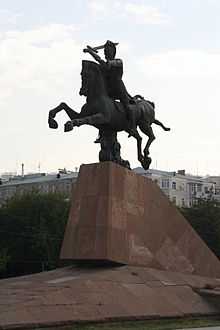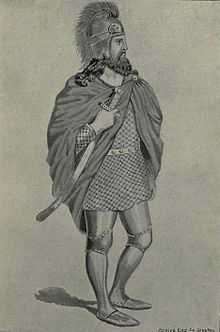Vardan Mamikonian
| Vardan Mamikonian | |
|---|---|
|
Vardan Mamikonian illustration in 1898 book Illustrated Armenia and Armenians[1] | |
| Born | 393 |
| Died | 451 |
| Rank | Sparapet |
| Battles/wars | Battle of Avarayr |

Vardan Mamikonian (Armenian: Վարդան Մամիկոնյան; 393 AD — 451 AD) was an Armenian military leader, a martyr and a saint of the Armenian Church. He is best known for leading the Armenian army at the Battle of Avarayr in 451, which ultimately secured the Armenians' right to practice Christianity.
A member of the Mamikonian family of Armenia's highest caliber aristocrats (known as nakharars), is revered as one of the greatest military and spiritual leaders of Armenia, and is considered a national hero by Armenians.[2][3] According to Arshag Chobanian "To the Armenian nation, Vartan [...] is the most beloved figure, the most sacred in their history, the symbolical hero who typifies the national spirit."[4] Major Armenian churches are named after Saint Vardan. Equestrian statues of St. Vardan are found in the Armenian capital Yerevan and in the country's second largest city - Gyumri.
Biography
Vardan Mamikonian was born in 393 AD to Hamazasp Mamikonian (in Armenian Համազասպ Մամիկոնյան) and to Sahakanoush(in Armenian Սահականուշ), daughter of Isaac of Armenia.
After Vardan became Sparapet (supreme commander of the armed forces) in 432, the Persians summoned him to Ctesiphon. Upon his return home in 450 AD, Vardan repudiated the Persian religion and instigated an Armenian rebellion against their Sassanian overlords.
Vardan died in the Battle of Avarayr on the Avarayr Plain in Vaspurakan. The also known as the Battle of Vardanants, was fought on May 26, 451 AD on the Avarayr Plain in Vaspurakan, between the Armenian Army under Saint Vardan and the Sassanid (Persian) rulers. While the Persians were victorious on the battlefield itself, with Vardan killed in battle, the Battle of Avarayr paved the way for the compact between Persians and Armenians that guaranteed religious freedom for Christian Armenians.
After his death, the insurrection continued led by Vahan Mamikonian, the son of Vardan's brother, resulting in the restoration of Armenian autonomy with the Nvarsak Treaty (484), thus guaranteeing the survival of Armenian statehood in later centuries.
- Family
Vardan Mamikonian is the father of Vardeni Mamikonian (known also Shushanik), born around 409 AD. She married Varsken. When her husband, a prominent Mihranid feudal lord (pitiakhsh) Varsken took a pro-Persian position renouncing Christianity and adopting Zoroastrianism, he tried to force his wife Shushanik to convert, but she refused vehemently to submit to his orders to abandon her Christian faith and was put to death in 475 AD on Varsken's orders. Shushanik has been canonized by the Georgian Orthodox and Apostolic Church and is venerated by the Armenian Apostolic Church. Known as Saint Shushanik, her feast day is celebrated on October 17.
Veneration
After his death, Vardan Mamikonian was consecrated as a saint of the Armenian Apostolic Church.
He is also revered by the Armenian Catholic Church as a saint of the church and by Armenian Evangelical Church.
His commemoration day in the official Armenian Church calendar is usually in the month of February and on very rare occasions may fall in the first week of March. The actual Saint Vardan day is a moving day, as it always has to fall on a Thursday.
Major Christian Armenian churches are named after Saint Vardan, including the St. Vartan Cathedral in New York City.
Vardan or Vartan are both common given names for Armenian males, the female version is Vardanoush or Vartanoush. Vardanyan, Vardanian, and Vartanian are also common Armenian family names.
References
- ↑ Vartan Mamikonian illustration in 1898 book «Illustrated Armenia and Armenians»
- ↑ Robert Armot, Alfred Aghajanian (2007). Armenian literature: comprising poetry, drama, folklore, and classic traditions. Los Angeles, CA: Indo-European Pub. p. 5. ISBN 9781604440003.
- ↑ Suny, Ronald Grigor (1993). Looking toward Ararat Armenia in modern history. Bloomington: Indiana university press. p. 4. ISBN 9780253207739.
- ↑ Tchobanian, Archag (1914). The people of Armenia: their past, their culture, their future. G. Marcar Gregory (translator); Viscount Bryce (introduction). London: Dent. pp. 10-11.
